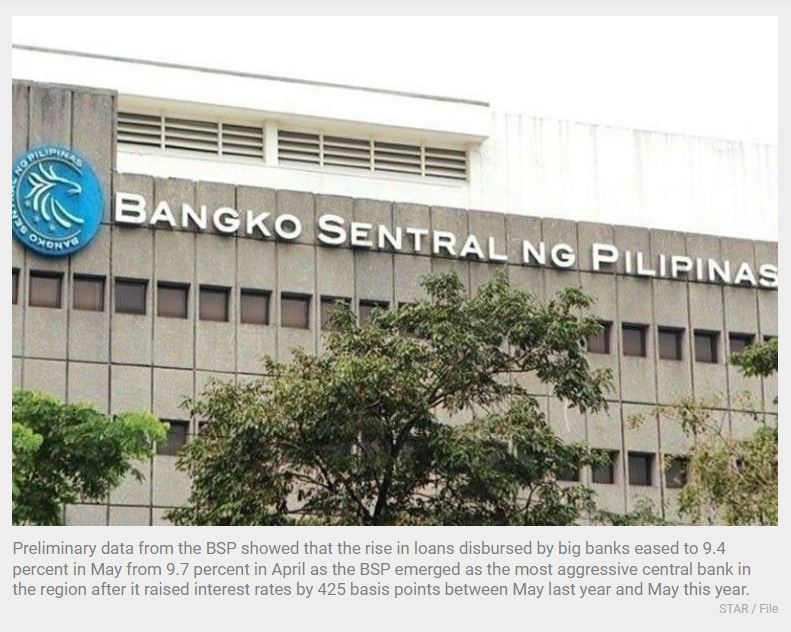Philippines: Credit growth slows in May
MANILA, Philippines — Credit growth slowed for the second straight month and remained at single-digit level in May, reflecting the impact of the year-long tightening cycle by the Bangko Sentral ng Pilipinas (BSP) to fight inflation and stabilize the peso.
Preliminary data from the BSP showed that the rise in loans disbursed by big banks eased to 9.4 percent in May from 9.7 percent in April as the BSP emerged as the most aggressive central bank in the region after it raised interest rates by 425 basis points between May last year and May this year.
“The moderation in bank lending activity reflects the impact of the BSP’s cumulative policy rate adjustments. Looking ahead, the BSP will continue to ensure that domestic liquidity and credit dynamics are in line with its price and financial stability mandates,” the central bank said.
Universal and commercial banks disbursed a total of P10.91 trillion in loans as of end-May, P973 billion higher than the P9.97 trillion released in end-May last year.
Rizal Commercial Banking Corp. chief economist Michael Ricafort said the slower bank loans growth was partly due to the rising trend in US and local interest rates in recent months, as well as higher prices.
Ricafort said this translates to higher borrowing costs for consumers, businesses and other institutions that, in turn, partly slowed down the demand for loans as central banks battled elevated inflation.
He also cited the risk of recession in the US, which is the world’s largest economy, although this is offset by the economic reopening in China, which is the world’s second biggest economy.
Ricafort believes that further easing trend in year-on-year inflation for the coming months would eventually help ease interest rates and spur loan demand.
Inflation averaged 7.5 percent in the first five months, still above the BSP’s two to four percent target range after easing to a 12-month low of 6.1 percent in May from 6.6 percent in April.
This allowed the BSP to extend its prudent pause as it kept the benchmark interest rate untouched at 6.25 percent for the second straight rate-setting meeting last June 22.
Ricafort said the lowering of the reserve requirement ratio by 250 basis points for big banks as well as 100 basis points for mid-sized and small banks could release P350 billion in additional liquidity in the financial system.
However, he said that the additional liquidity could be absorbed by the central bank’s facilities with the newly introduced 56-day BSP securities on June 30.
For April, the rise in loan releases to production activities slowed further to 7.9 percent from 8.3 percent in April to reach P9.5 trillion from P8.8 trillion in the same month last year and accounted 87 percent of the total disbursements.
Disbursements to the volatile real estate sector accelerated anew to 5.5 percent with P2.19 trillion that accounted for 20.31percent of the total, followed by the wholesale and retail trade, repair of motor vehicles and motorcycles with a slower increase of 8.6 percent to P1.23 trillion for an 11.3 percent share.
Source: https://www.philstar.com/business/2023/07/03/2278151/credit-growth-slows-may


 Thailand
Thailand




